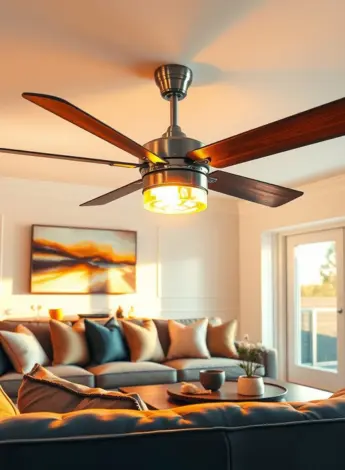
Introduction
Ceiling fans are a reliable and energy-efficient way to keep your home comfortable year-round. But like any electrical appliance, they can occasionally stop working. Whether your fan won’t turn on, spins slowly, or behaves erratically, understanding the underlying cause is the first step toward a solution. Many homeowners search for answers after encountering a Harbor Breeze ceiling fan not working, and while the issue may seem frustrating at first, it’s often easy to diagnose with a bit of guidance.
In this article, we’ll explore how to systematically troubleshoot a non-working ceiling fan, common causes of failure, and why Harbor Breeze fans are a popular and dependable choice among homeowners.
Step 1: Confirm Power Supply
The first and most basic step is to ensure the fan is getting power. Begin by checking if other devices in the same room are functioning—like lights or wall outlets. If they aren’t, the issue could be a tripped circuit breaker or a blown fuse. Head to your breaker box and inspect the relevant switches. If one is out of position, reset it and test the fan again.
Also, make sure the wall switch connected to the fan is turned on. In some homes, the switch may control power to both the fan and a light fixture, so toggling it may bring the fan back to life.
Step 2: Test the Remote or Pull Chain
Modern ceiling fans often come with remote controls. If your fan isn’t responding, it could be due to a dead battery, interference, or a pairing issue. Replace the remote’s batteries and make sure there’s nothing blocking the signal. For pull-chain models, pull the chain to ensure the fan isn’t manually turned off.
If the fan still doesn’t operate, move on to the next diagnostic step.
Step 3: Inspect the Wiring
Wiring issues are a common culprit behind non-working ceiling fans. If the fan was recently installed or modified, it’s possible that a wire has come loose. Turn off power at the breaker, then remove the fan canopy to check for disconnected or frayed wires. Ensure all wire nuts are securely fastened and look for any signs of scorching or damage.
If you’re not comfortable working with electrical components, it’s best to contact a licensed electrician for safety.
Why Choose Harbor Breeze Ceiling Fan?
When it comes to ceiling fans, Harbor Breeze is one of the most trusted names on the market. Available exclusively at Lowe’s, Harbor Breeze fans offer a mix of stylish designs, affordability, and reliable performance. Whether you’re looking for a fan with a built-in light fixture, a remote control, or one that complements modern or rustic décor, there’s a Harbor Breeze model that fits your needs.
What sets Harbor Breeze apart is its user-friendly installation, quiet motor operation, and extensive selection of styles and finishes. Many models are Energy Star certified, which helps reduce energy consumption without sacrificing performance. And if you ever encounter issues such as a Harbor Breeze ceiling fan not working, customer support and replacement parts are easily accessible, making troubleshooting less stressful.
These features, combined with a solid warranty and reputation for quality, make Harbor Breeze an excellent choice for homeowners seeking value and performance in a ceiling fan.
Step 4: Examine the Capacitor and Motor
If your ceiling fan has power but still doesn’t turn on, the internal components may be to blame. The capacitor is responsible for starting the motor and maintaining speed. A faulty capacitor can prevent the fan from spinning or cause it to operate slowly.
Similarly, a worn-out motor can cause the fan to stop working entirely. These issues are more common in older fans or ones that have run for extended periods without maintenance. Replacing a capacitor is usually straightforward, but a motor replacement may require professional help or a complete fan replacement.
Step 5: Check the Receiver Unit
For ceiling fans that use remote controls, a small receiver unit inside the fan housing processes the remote’s signals. If this receiver malfunctions, the fan won’t respond even if the remote is working. To test this, you can bypass the receiver by connecting the fan directly to the power supply (if you’re comfortable doing so), or replace the receiver with a new compatible unit.
Step 6: Look for Overheating or Safety Shutdowns
Some ceiling fans have built-in thermal fuses or automatic shutdown features to prevent overheating. Dust buildup, poor airflow, or long periods of continuous use can trigger these safety systems. Turn off the fan at the breaker and allow it to cool for 30 minutes, then try turning it on again.
Cleaning the blades, motor housing, and vents regularly can help prevent overheating in the future.
Step 7: Consider the Age of the Fan
Ceiling fans have a lifespan of 10 to 15 years depending on usage and maintenance. If your fan is older and showing multiple signs of failure, it may be more cost-effective to replace it than to attempt multiple repairs. Upgrading to a newer model, such as one from the Harbor Breeze lineup, can also provide benefits like improved efficiency, quieter operation, and modern controls.
Final Thoughts
Diagnosing a non-working ceiling fan doesn’t have to be complicated. By following a step-by-step approach—starting with the power source and progressing through wiring, components, and controls—you can often pinpoint the issue quickly. If you find your Harbor Breeze ceiling fan not working, rest assured that many problems are minor and easily fixable with basic tools and knowledge.
Choosing a reliable brand like Harbor Breeze ensures long-term performance, accessible support, and peace of mind. With the right troubleshooting techniques and a quality fan, you can restore comfort and functionality to your living space in no time.